As a seasoned German Shepherd owner and someone who has dedicated over three decades to working with these magnificent dogs in law enforcement, I’ve encountered my fair share of challenges.
Among these, teaching a German Shepherd not to pull on the leash stands out as a common hurdle for many owners.
So, here’s the short answer to turning those tug-of-war walks into a thing of the past….
To stop a German Shepherd from pulling on a leash, use positive reinforcement. Train in a distraction-free area and reward calm behavior and loose-leash walking with treats and praise. Ensure you use a suitable harness and leash. Gradually introduce more distractions to reinforce good behavior.
Drawing from years of experience and countless hours of training, I’ll tell you effective strategies that can transform your walks into the pleasant and controlled outings they should be.
Key Takeaways:
- Positive reinforcement is vital for teaching your German Shepherd to walk nicely on a leash.
- A proper harness and leash setup can significantly improve control and comfort for you and your dog.
- Consistent practice in varied environments reinforces good leash behavior, ensuring your dog becomes a well-mannered walking companion.
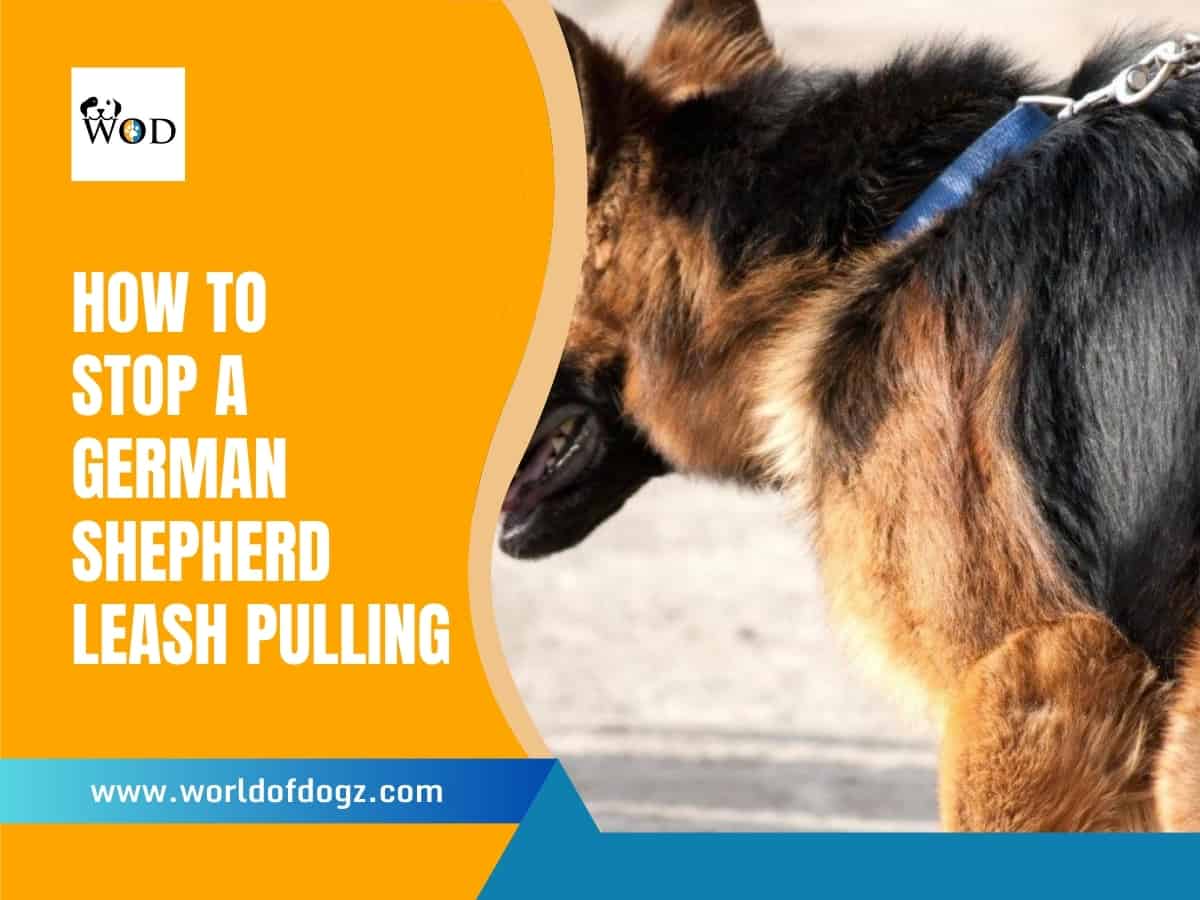
How To Stop a German Shepherd From Pulling on The Leash
Imagine yourself running behind your German Shepherd because he’s pulling on his leash and dragging you along. That’s no pleasant experience!
Onlookers could build the idea that roles are overturned and your dog is taking you for a walk instead of the opposite!
Leash pulling is quite common among dogs: 82.7% of dog owners reported leash pulling, according to a UK study on lead-pulling behavior in pet dogs.
If left unattended, consistent pulling can become a serious concern for dog owners and eventually cause harm to your German Shepherd’s health and welfare.
Let’s explore what these anti-leash-pulling tactics entail.
1. Train Your German Shepherd in Loose Leash Walking
Your German Shepherd should be trained in loose leash walking as a puppy. Once learned, you should reinforce this behavior consistently.
Puppy training should start when you get your new pup, usually around eight weeks. Here’s my beginner’s guide on training an 8-week-old German Shepherd for greater insight.
If your German Shepherd resumes leash pulling in adulthood, you’ll need to retrain your dog in loose leash walking once again.
There are various methods of loose leash walking training you can choose from. You’ll need to find out what works best for your German Shepherd.
Here, I discuss the lure and reward as a method you could consider to retrain your German Shepherd in loose leash walking.
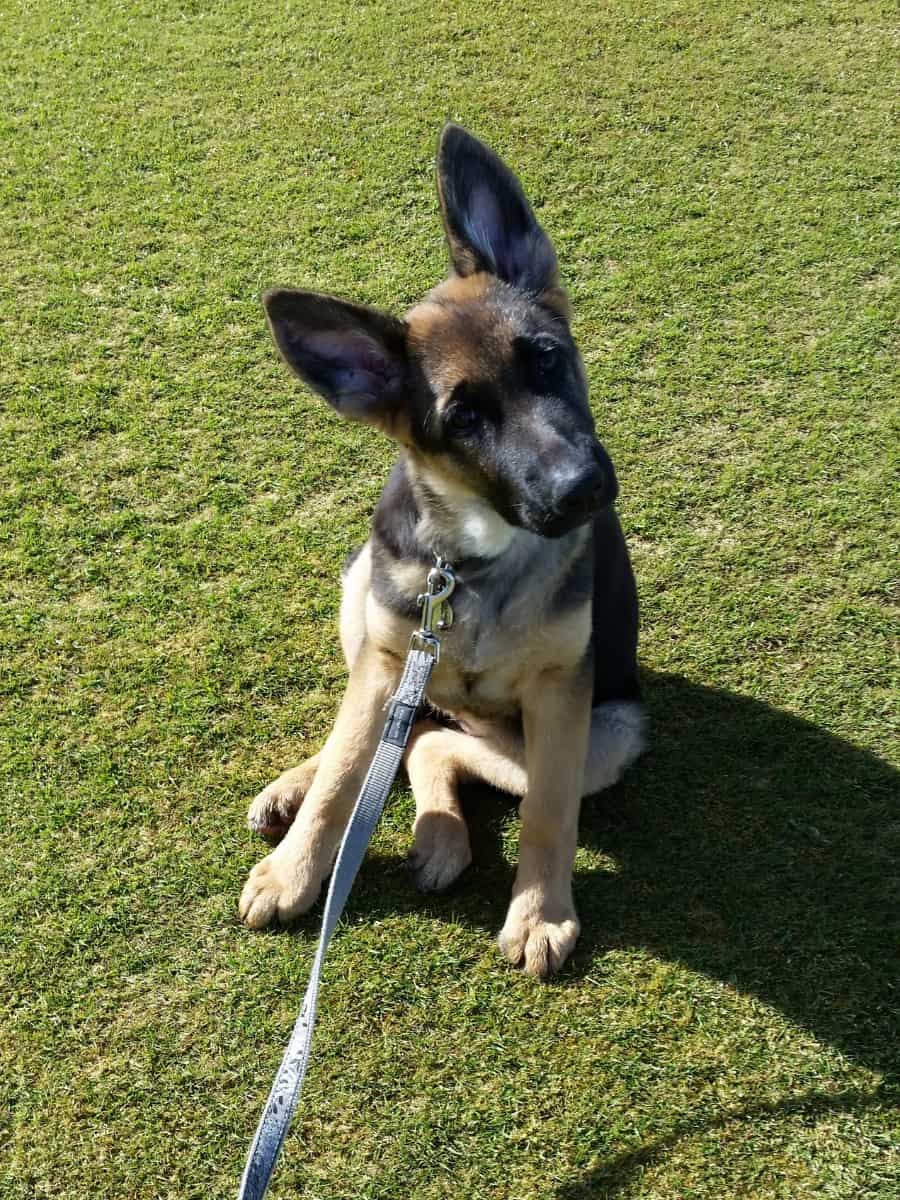
Lure and Reward Loose Leash Walking Training
As the name suggests, the lure and reward method aims to lure your German Shepherd into stopping lead pulling and walking on a loose leash instead by offering a reward each time he does it.
Follow these steps to train your German Shepherd in loose leash walking using the lure and reward method:
- Have your German Shepherd stand next to you on your left side.
- Hold his favorite treats in your right hand and bring them close to your dog’s nose so he can smell them and anticipate getting some.
- Use a familiar word cue to direct your GSD to start walking with you. It could be “LET’S WALK!” or “WALK!” depending on what you’ve trained your pup.
- As your dog walks next to you, give him a treat every few minutes and praise him for walking close to you.
- When your German Shepherd pulls on the leash, stop walking and stand firm in your position. The leash will feel tight on your dog’s neck, and he will stop to see what you are doing. Your dog will then come closer, and the leash will be slack. If he does not come back to you, call him back.
- Pass the treats in front of your dog’s nose again when he comes close, and resume walking in the intended direction. Reward your pup for walking next to you every few steps so he begins to associate loose leash walking with rewards.
- Repeat the drill daily and increase the distance walked each day until your dog is no longer pulling on the leash.
- When it appears that your dog has learned not to pull on the lead, stop passing the treats near your dog’s nose before initiating the walk and extend the intervals between treats.
With time, your dog should walk on a loose leash without any luring. However, sustain the habit of giving a treat now and then while you walk to firm the behavior.
Watch this video to show how powerful the lure and reward method can be in making your German Shepherd focus on you and stay close to you.
Loose Leash Walking…
2. Train Your German Shepherd in Reliable Recall
Reliable recall is the term used to describe your dog’s ability to respond to your call always promptly, or at least most of the time.
Training your German Shepherd in reliable recall is especially beneficial when leash pulling is caused by distractions in the surroundings or by prey chasing.
Follow these steps:
- Take your German Shepherd for a walk, and stay keen to notice your dog being distracted by noises, smells, or small animals.
- If your GSD starts to pull on the leash, call him to you using a known cue word like “COME!”
- Reward your dog if he stops pulling on the leash and comes to you with a cue word said excitedly, like “GOOD DOG!” or “YES!” and accompany the verbal reward with a treat. This makes your GSD associate come over to you with good things.
- Repeat this process a few times a day and for several days until your dog learns that he’s not allowed to pull the leash but should return to you every time he’s called.
You can vary the situations from walks to park visits and other places where people or other dogs can serve as sources of distractions and make your GSD pull on the lead.
3. Avoid Reinforcing Your Dog’s Leash Pulling
Dogs pick behavior through reinforcement learning.
While positive reward-based training is intentionally used to train dogs in proper behavior, negative dog behavior can also be unintentionally reinforced through dog owners’ actions that the dog finds rewarding.
The unintended reward makes your dog more likely to repeat the behavior.
Some ways you’ll reinforce leash pulling include:
- Following your dog when he pulls you.
- Allowing your dog to sniff the bush.
- Letting your dog greet people.
- Allowing your dog to pursue prey.
While these behaviors are okay under normal circumstances, allowing them when your German Shepherd pulls on the lead reinforces leash pulling. This happens because your dog gets what he wants.
Instead, you should plant your feet and call your dog back to you, then reward him when he does come to you.
You could reward your pup by turning and walking in his desired direction once he stops pulling the leash, comes to you, and walks with you on a loose lead.
That way, your GSD learns he can get what he wants if he behaves well and does not pull on the leash.
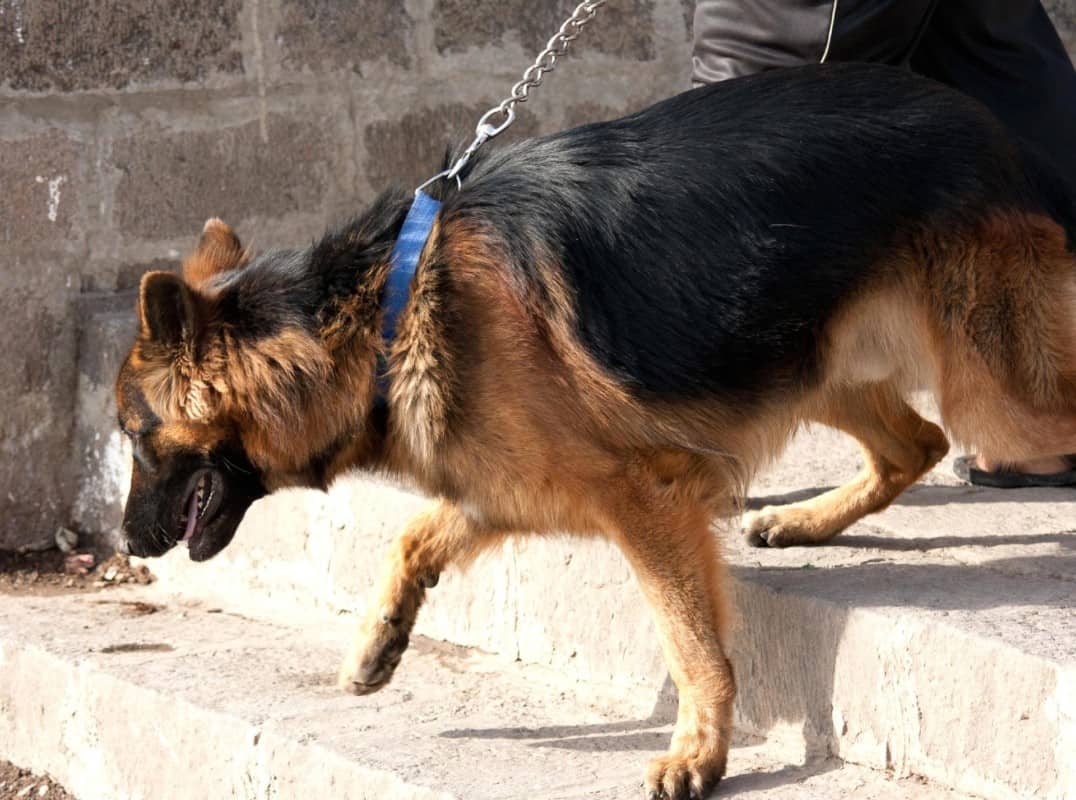
4. Keep Your German Shepherd Engaged While Walking
German Shepherds are friendly dogs that love interacting with their owners and family. Their need to relate with their owners does not take a break during walks or when in public places.
As such, you should talk and communicate with your German Shepherd while walking. Hearing your voice will keep your dog focused on you and the walk experience.
You can reward your dog every time you talk to him, and he turns to look at you. If he turns to you after some silence, reward that too to affirm his attention to you and call him to keep walking (“LET’S WALK!”).
5. Exercise Your German Shepherd Before the Walk
Exercising your GSD before a walk may sound like double exercise, but tiring out your German Shepherd with engaging activity before taking a walk will make your dog use up the energy he would otherwise spend on pulling on the leash.
A simple walk or two daily may not be enough for your high-energy German Shepherd. So you can schedule a game of fetch or tug of war just before the walk so your dog does not look for an additional way to be engaged.
6. Do Relaxation Training Before the Walk
I mentioned earlier that your German Shepherd pulls on the lead because he is excited about the walk or the destination.
If this is your case, you can stop a German Shepherd from pulling by calming him down before commencing the walk.
Here’s how to stop your German Shepherd from pulling on his lead by calming him down before the walk:
- Identify a familiar route for you and your dog’s walk, one that’s quiet and without much distraction.
- Prepare your GSD for the walk by fixing his neck collar or harness. Then, have your dog sit patiently to wait for you as you get ready.
- Use a front clip harness, like the Walk Your Dog With Love No-Pull Harness. This is the harness my Shepherd uses. As it’s not rear-attached but leads from the front, it gives better steering and greater control. The front clip makes your pup walk by your side; if he tries to pull, he will rotate toward you.
- If your German Shepherd begins to get excited, maybe he has realized you are heading to a destination that excites him. Stop whatever you are doing and direct your dog to sit calmly. Once he is calm, continue with your preparation.
- If your dog begins to get excited again, move away as though giving up the walk until he calms down. Be sure to use a calm tone when directing your dog to sit or calm down. An agitated tone can animate your pup even more.
- When your dog has stopped getting excited, proceed for the walk.
Note: Clicking the above link(s) will take you to Amazon or an online store where we have an affiliate relationship. If you make a purchase, we may earn a commission at no additional cost to you.
Before starting the walk, this calming exercise should not only calm your dog’s nerves but also teach him that the walk will only happen if he is calm and preempts any excited behavior like pulling on the leash.
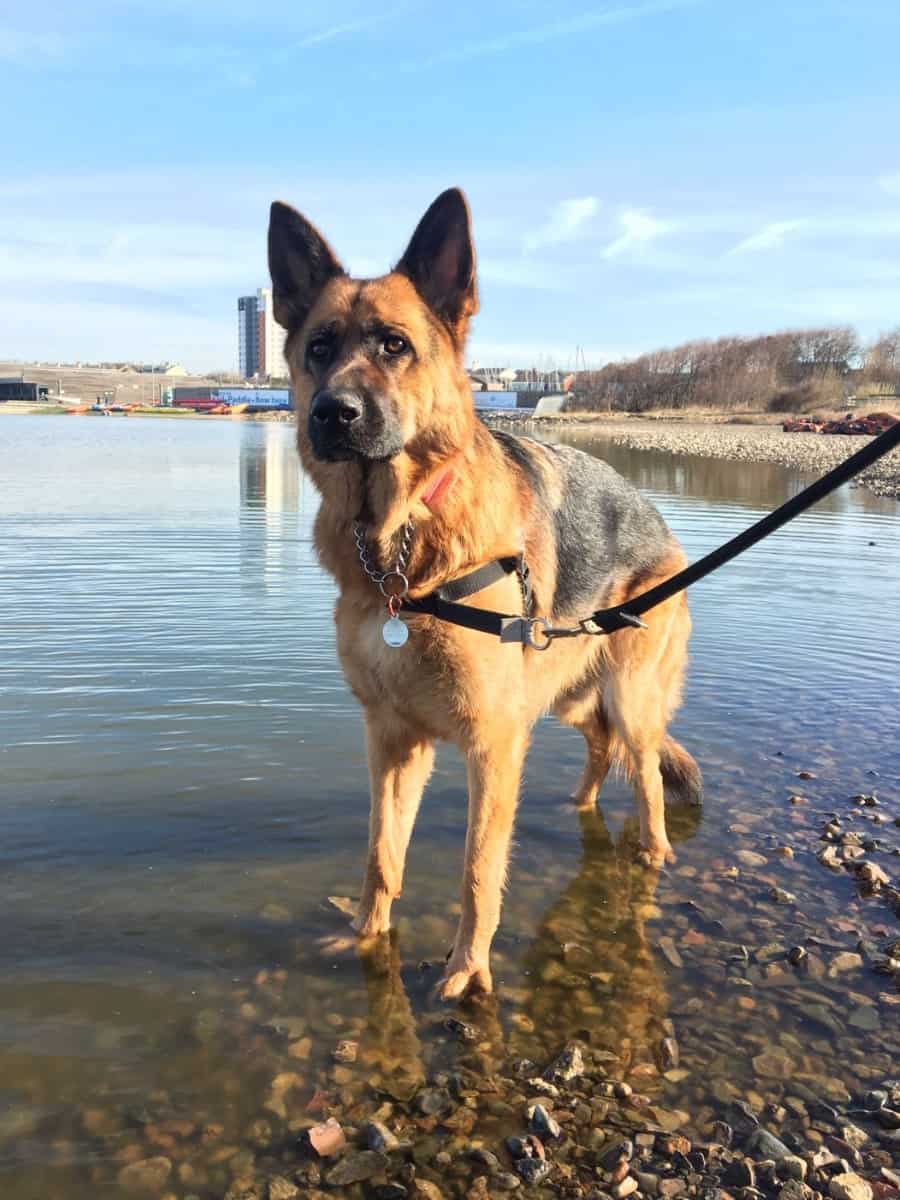
7. Perpetuate Loose Leash Walking with Rewards
Perpetuating loose leash walking is more of a preventive method for stopping leash-pulling than a corrective one.
But it should be performed continuously, so we include it among the corrective leash-pulling methods.
While formal dog training in housebreaking, obedience, and socialization is usually complete by the time your German Shepherd is a year old, maintaining your dog’s learned behavior needs perpetuating.
Rewarding your adult German Shepherd when he stays close to you and does not pull the leash during your daily walks sustains the dog’s understanding that loose leash walking is the desired behavior, and he will persist in it.
The Reasons Behind Your German Shepherd’s Leash Pulling
A German Shepherd pulls on the leash because it’s the canine way to engage with the surroundings, people, or other moving animals and objects.
Being attached to you with a leash can appear to derail your dog’s goal of getting where he wants, which is why he pulls on it.
While this is the primary reason why your German Shepherd pulls on the lead, other specific causes can make your dog pull on the leash. Here are five other reasons:
Your Dog Was Not Trained Not To Pull on the Leash
Pulling on a leash is a somewhat natural behavior for your dog.
So, if your GSD was never trained to stop this behavior and walk on a loose lead, pulling on the lead can seem natural for your dog when he needs to get where he wants. After all, no one told him it was not okay to pull on his leash!
Your German Shepherd Takes the Lead in Walks
If your German Shepherd has assumed the lead role by walking ahead of you during your daily walkies, he will likely pull on the leash when he wants to go faster or change direction towards something that interests him.
Just by walking ahead of you and regularly pulling on the lead, the leash-pulling behavior is rewarded and reinforced. Your German Shepherd will learn this as acceptable behavior.
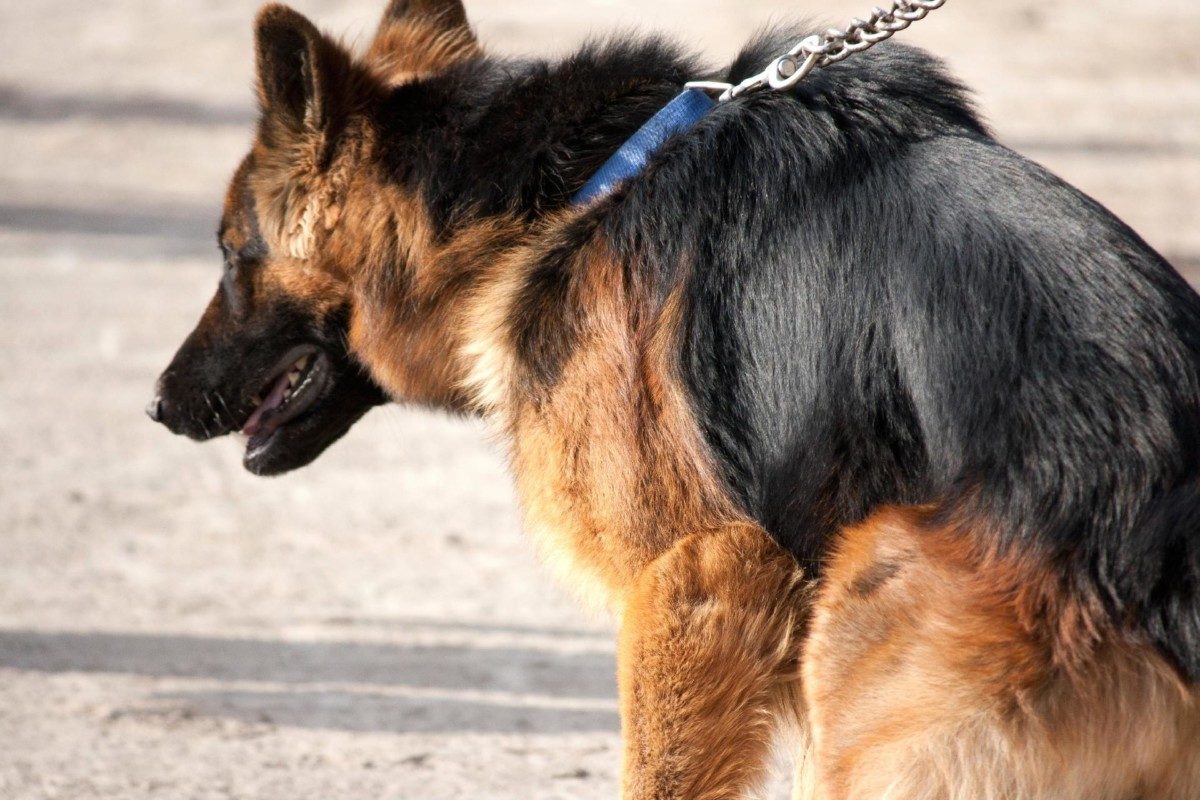
Your German Shepherd is Excited About a Destination
If your German Shepherd knows where you are going and is excited about getting there, he may pull on the lead to make you hurry up.
It could be a visit to his preferred dog park, where he meets and interacts with other dogs, or a dog amusement park.
Even though it is still under study, there is reliable evidence that dogs have an episodic-like memory, meaning they can remember the ‘what’, ‘where’, and ‘when’ aspects of events and retrieve info from the event accordingly.
This is why your German Shepherd might anticipate your destination by referring to past times and actions before a walk and getting excited about heading there.
There Are Distractions in the Surroundings
German Shepherds are originally herding dogs with a strong prey drive.
If you are taking your daily walk and your German Shepherd notices a squirrel or other small animals crossing your path, his natural instinct to pursue the prey can be ignited, causing your dog to start pulling on the leash.
Distractions that could cause your German Shepherd to pull on the lead could also come from the presence of people, other dogs, or an enticing sound or smell.
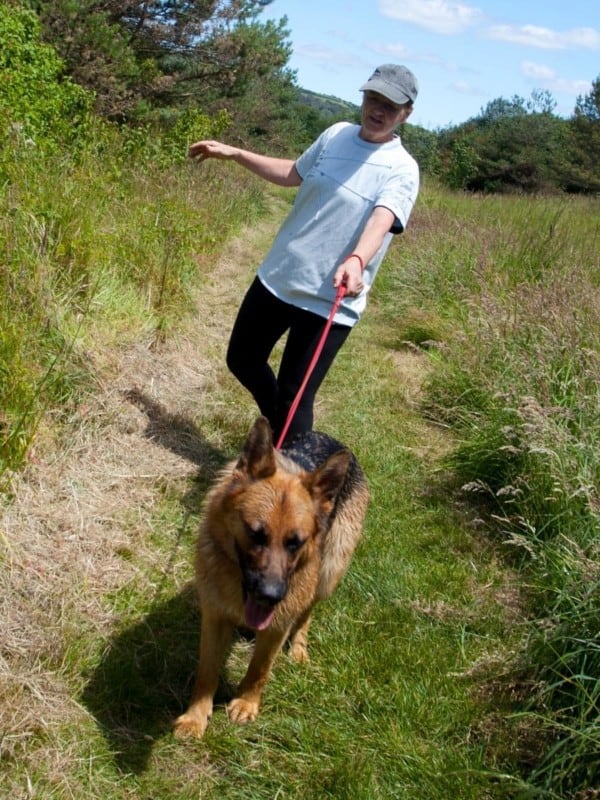
You Are Too Slow for Your German Shepherd!
German Shepherds are high-energy dogs and must spend this energy on vigorous exercise.
If you take a walk and move at a chameleon pace, your German Shepherd will find it hard to walk at this pace and may decide to pull on the leash to tell you you are too slow for him.
This is especially true if your dog does not have alternative exercises to spend his energy on.
Considering the above leash-pulling causes, your next question is likely how to stop a German Shepherd from pulling on the leash.
You Are Using The Wrong Collar/Leash
Most new pet owners commit the mistake of using the wrong collar or leash for their dogs and causing inconvenience (even without their knowledge).
Choosing the right leash and collar for your German Shepherd prevents them from pulling on the leash during walks.
A leash and collar that are poorly fitted or not appropriate for your dog’s size and strength can make it difficult to control them, leading to frustration for both you and your dog.
Additionally, using the wrong type of collar or leash can cause discomfort or even injury to your dog, making them more resistant to leash training in the future.
To choose the right leash and collar for your German Shepherd, consider their size, strength, and behavior.
A strong, active dog may require a sturdier leash and collar than a smaller, less active dog.
For dogs that tend to pull on the leash, a no-pull harness or head collar may be a better option than a traditional collar or leash.
It’s also important to ensure that the collar and leash are properly fitted to your dog’s neck and body, with enough room for them to move comfortably but not so loose that they can slip out of it.
When selecting a leash, consider the length and material.
A shorter leash may provide more control over your dog, while a longer leash may allow them more freedom to explore.
Nylon leashes are popular for their durability and affordability, but leather leashes may be more comfortable for your hands and provide a more classic look.
FAQs
How often should I practice leash training with my German Shepherd?
For best results, practice leash training with your German Shepherd daily, in short sessions of 10-15 minutes. Consistency and repetition are vital for reinforcing positive leash behaviors.
Is it ever too late to train a German Shepherd not to pull on the leash?
No, it’s never too late to train a German Shepherd not to pull on the leash. With patience, consistency, and the right training techniques, dogs of any age can learn to walk nicely on a leash.
How long does it take to train a German Shepherd not to pull on the leash?
It typically takes a few weeks to several months to train a German Shepherd not to pull on the leash, depending on the consistency of training, the dog’s age, and previous leash habits.
Let’s Sum This Up!
You don’t have to give up your GSD-owner bonding time. Leash pulling can be reversed!
- First, know why your German Shepherd is pulling on the leash: it could be a lack of previous training, excitement about the destination, or you’ve let your dog take the lead on walks and reinforced leash pulling.
- Next, use corrective methods to stop leash pulling: retrain your dog, avoid reinforcing leash pulling, exercise and calm your GSD before walks, and perpetuate loose leash walking with rewards.





